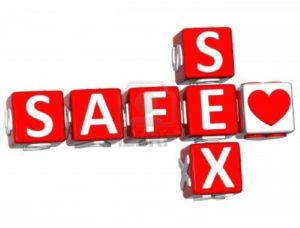 Do you notice how often people refer to “Safe Sex”? The phrase is misleading. Many would say it is a lie. There is no such thing as “safe sex.”
Do you notice how often people refer to “Safe Sex”? The phrase is misleading. Many would say it is a lie. There is no such thing as “safe sex.”
There is SAFER Sex. When you talk to people about being safer with sex, please always include the “r” at the end of “safer.”
“Safe Sex” implies all the risk is gone – that you are completely free of all risk while engaging in sexual activity.
Here are the facts:
- While condoms (when properly used) GREATLY reduce the risk of spreading STIs and STDs, they are not perfect. In addition to the 1% – 2% failure rate of condoms, STIs can still be passed via skin contact that occurs where the condom is not covering.
- BIGGEST OXYMORON: “The only true form of safe sex is abstinence.” Abstinence is not “safe sex” – it is NOT SEX in any form or manner. The entire definition of abstinence is to “abstain from sex” – so please stop people from saying, “The only true from of Safe Sex is abstinence.” Many students instantly recognize that statement as an oxymoron. Thus you only lose credibility with students. This doesn’t mean to stop discussing abstinence. Just don’t equate it with “safe sex.”
- HUGE MYTH: Be monogamous and you’ll always be safe. Unfortunately sometimes a loving partner will still withhold parts of their sexual past from you – for fear of your reaction (including disappointment). While you may be 99% sure your partner has told you everything, you can’t be 100% positive.
- EMOTIONAL RISK: Lets say you and your partner have NEVER been with anyone else and so you believe there is no chance of a STI or STD. Lets throw in that you use multiple forms of protection to make the possibility of a pregnancy to be less than 1%. You STILL take an emotional risk when engaging in sexual activity with another person. Feelings such as connection, attachment, and “love” can be in one of the partner’s heart and mind.
Be SAFER – talk truthfully about SAFER SEX.
Add the “r” to create “SAFER” discussions and you’ll gain great credibility while better preparing students for the potential consequences of their sexual decisions.
In addition to the ways we’ve mentioned above, how do you find the word “Safe Sex” to be dangerous and/or misleading?
SHARE YOUR ANSWERS IN THE COMMENTS SECTION BELOW.
Searching for Safe Sex
Do a “Google” image search for “Safe Sex” and you’ll notice all the imagery is about physical safety. In future blog posts, we’ll discuss what being “safer” means on an emotional level. How RESPECT is vital to all forms of safety.
